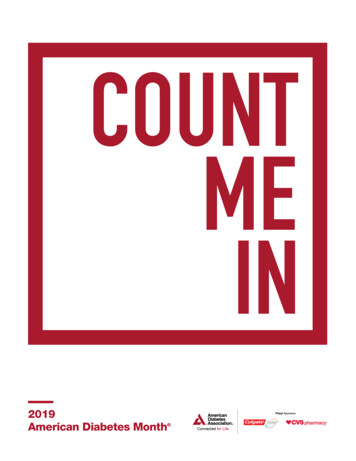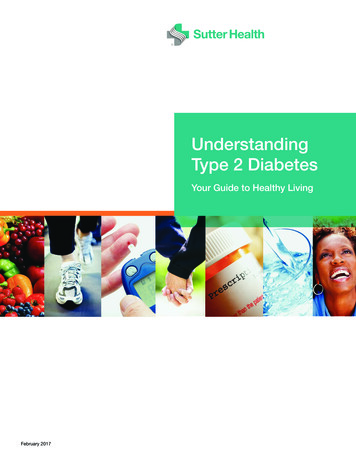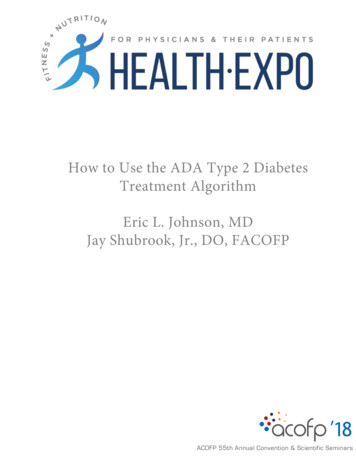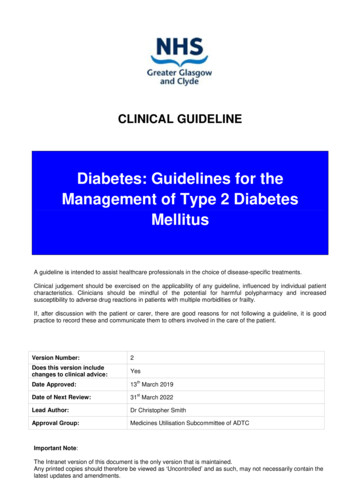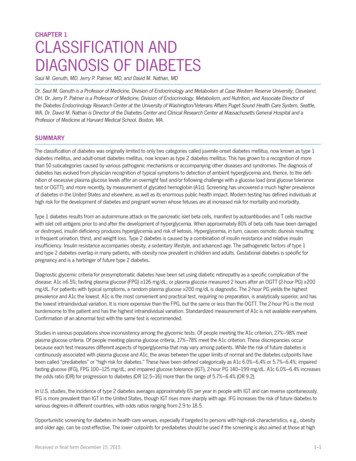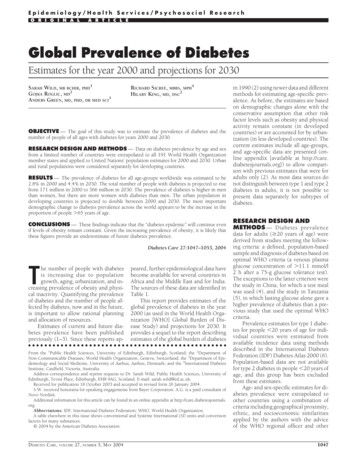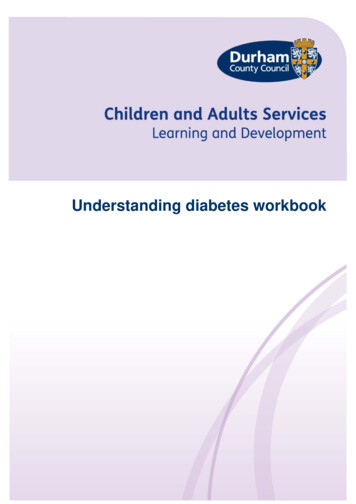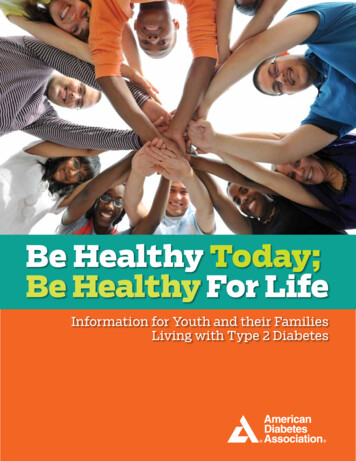
Transcription
Be Healthy Today;Be Healthy For LifeInformation for Youth and their FamiliesLiving with Type 2 Diabetes
Type 2 Diabetes in Youth1Table of ContentsTable of Contents2Acknowledgments3What Is Diabetes?6Manage Your Diabetes with STAR7Checking Blood Sugar8Staying Healthy9Taking Care of Diabetes with Medicines11Low Blood Sugar (Hypoglycemia) andHigh Blood Sugar (Hyperglycemia)14Healthy Food Choices19Choosing Lower-Fat Foods21How to Read Food Labels23Physical Activity25 Setting Goals, Problem Solving, and Managing Stress27Being a Teen with Diabetes31Glossary1-800-DIABETES (342-2383) diabetes.org
Type 2 Diabetes in Youth2AcknowledgmentsAcknowledgmentsThis information was first developed to deliver standard diabetes education to youth and their familiesparticipating in the TODAY (Treatment Options fortype 2 Diabetes in Adolescents and Youth) study. Thisstudy was funded by the National Institute of Diabetes and Digestive and Kidney Disease of the NationalInstitutes of Health.We thank the following people for suggestions, comments, and contributions: Jill Campbell, MS, RD, LD;Terri Casey, RN, CDE; Christie Givens, MS, RD, LD,CDE; Mary Larkin, MS, RN, CDE; Gerre McGinley, RD,LDN, CDE; Kerry Milaszewski, RN, CDE; Denise Richards, MSN, FNP, CDE; Paulina Rose, RD, CDE, CD-N;Aimee Dennis Wauters, MS, RD, LD, CDE.The education manual was developed by BarbaraSchreiner, PhD, RN, CDE, BC-ADM, and copyrighted byBarbara Schreiner. Other individuals who contributedas members of the TODAY Standard Diabetes Education Committee are:The American Diabetes Association has worked withadditional leading experts to offer these materials tosupport the education and care of all youth with type2 diabetes and their families.Margaret Grey, DrPH, FAAN, CDE (committee chair)Cindy Cain, CDENancy Chang, CDEKenneth Copeland, MDLinda Delahanty, MS, RDNicole Jacobs, MS, RD, CDEChris Macha, RD, LD, CDESue McGirk, RN, CDESuzanne Meyer, RN, CDEGuadalupe Rupert, CDEThese materials provide an easy-to-use version ofthe TODAY study standard education manual. It canbe used by the youth and family themselves or inpartnership with a certified diabetes educator orother member of the youth’s health care team. Allaspects of health care need to take into accountthe special circumstances of the individual patient.A number of different approaches for managingdiabetes are introduced in these materials. Theyouth should work with health care professionals todetermine which strategies are best for him or her.The American Diabetes Association’s Youth Strategies Committee reviewed and shortened thesematerials from their experiences in the TODAYstudy and from their years of work with thousandsof youth and their families. Special thanks go to:Lori Laffel, MD, MPH, co-ChairJoni Beck, PharmD, BC-ADM, CDE, co-ChairLaurie Higgins MS, RD, LDN, CDEIrl Hirsch, MDKorey Hood, PhDJean Lawrence, ScD, MPH, MSSAPatrice Yasuda, PhDJennifer Puryear, MPH1-800-DIABETES (342-2383) diabetes.org
Type 2 Diabetes in Youth3What is Diabetes?What is Diabetes?Diabetes is a serious disease. With diabetes, your body can’t turn the food you eat into energy.A few things are supposed to happen when you eat:EAM Food changes to a sugar called glucose. This sugar (glucose) is your body’s main fuel source. (You may hearpeople say blood sugar instead of blood glucose. They mean the same thing!) Glucose goes into the blood. It moves through the bloodstream to your body’s cells. Your blood glucoselevel starts to go up. Your body sends a message to the pancreas. The pancreas sits behind yourstomach and makes insulin. When your body needs it, your pancreas sendsinsulin into the blood.PANCREAS Insulin travels to the cells. Insulin is the key that opens the door to letglucose into a cell. Your cells use the glucose for energy. As glucose leaves the bloodstreamCELLRand goes into the cells, your blood glucose level comes back down.STB LOFor all this to work, your body has to have insulin.ODIn this picture, the pancreas is making insulin. Insulin goes into the bloodstream to open the cell doors. Insulin lets the glucose in the blood move intothe cells. Once the glucose is inside, the cells can make energy for your body.The two main types of diabetes are type 1 and type 2. Diabetes develops whenthe body can't make enough insulin, can't use the insulin well, or both.How did I get diabetes?We don’t know exactly what causes diabetes. Type 2 diabetes usually happens in adults, but more and moreyouth are developing it. These young people often: Are not very activeWeigh too muchHave other family members with type 2 diabetesHave high blood pressureAre African AmericanAre Hispanic AmericanAre American IndianAre Asian AmericanIs it my fault?Don’t blame yourself. Think about ways to become and stayhealthy. Some of these risks you CAN change. You canchange how active you are and what type of food you eat.Type 2 Diabetes in Youth 221-800-DIABETES (342-2383) diabetes.org
Type 2 Diabetes in Youth4What is Diabetes?Type 1 DiabetesEAMPANCREASB LOSODTRCELLIn this picture, the pancreas is not making insulin. The cells have enoughdoors, but no insulin is in the blood to open them. Glucose cannot movefrom the blood into the cells. Glucose stays in the bloodstream instead ofmoving into the cells to make energy for your body. Blood glucose levelsbecome high and unhealthy.Type 2 DiabetesEAMPANCREASB LOOTDSRSometimes the body stops making insulin. This is called type 1 diabetes.You must take insulin shots to stay alive and healthy.CELLSometimes cells don’t have enough doors or the pancreas doesn’t makeenough insulin. This is called type 2 diabetes.In this picture, the pancreas is making insulin but the cell doors are notworking. The glucose stays in the bloodstream because the doors don’topen. The glucose can’t get into the cells to make energy for your body.Blood glucose levels become high and unhealthy.What helps insulin open the doorsto let glucose in? Exercise and physical activity Eating healthy meals and snacks Losing weightThese things can help your body use insulin better.When you weigh more, your body needs more insulin.The pancreas has to work hard to make enough insulin.If it works too hard, it can get too tired and will needhelp.Diabetes pills don’t have insulin in them. They helpopen cell doors so your body can use the insulin it has.Some types of diabetes pills may help the body tomake more insulin.If your body can’t make enough insulin, you will needinsulin shots.What are signs that insulin is not working or the cell doors are not opening?Dark skin patches might appear on your neck, stomach, knees, elbows, armpits, hands, breast, or groin.These dark skin patches are called Acanthosis Nigricans, or AN for short. People whose body isn’t usinginsulin well (insulin resistant) often get AN.1-800-DIABETES (342-2383) diabetes.org
Type 2 Diabetes in Youth5What is Diabetes?Why should I worryabout my diabetes?Blood glucose (sugar) levels that stay high all the time can causeproblems. High blood glucose can: Make you feel sick, tired, sleepy, and thirstyLeave you without energy to play, work, or have funGive you blurry visionCause you to urinate (go to the bathroom) more oftenCause you to get up at night to go to the bathroomMake you sick more oftenMake it hard for infections and wounds to healDamage the blood vessels in your eyes, your kidneys, or your heartKeeping your blood glucose in a healthy range can prevent these problems as you get older.Will type 2 diabetesgo away?There is no cure for diabetes so it will never go away. Diabetes maychange over time so how you take care of it may need to change too.How can I take careof my diabetes?There are lots of ways to manage your blood glucose and your diabetes!Keep the level of glucose in your blood in a healthy range: Make healthy food choicesExercise and be active every dayTake your diabetes medicinesCheck your blood glucoseManage Diabetes with STARManaging diabetes means making choices—some easy, some hard. When faced with a decision, think STAR:STOP before you make a decision.THINK about your choices. Consider how they will affect you.ACT on the better choice for your health. Small steps add up to big results!REFLECT on your progress. Give yourself credit for healthy choices.1-800-DIABETES (342-2383) diabetes.org
Type 2 Diabetes in Youth6Manage Your Diabetes with STARManage Your DiabetesSTARwithLearn all you can about how to take care of yourself and your diabetes. It’s important to follow your treatment plan. Eat healthy and exercise Remember to take your medicine Check your blood sugar (also called glucose)Managing diabetes means making choices—some easy, some hard. When faced with a decision, think STAR:STARSTOPbefore you make a decision. What kind of snack is best to choose? Is itbetter to go for a walk or watch TV?THINKabout your choices before you act. How will they affect you and yourdiabetes care plan? For example, a piece a fruit will affect your blood sugar leveldifferently than a bag of chips.ACT on the better choice for your health. Remember, change is slow. No one ex-pects you to always choose the healthier option. Small steps add up to big results!REFLECT on your progress. Give yourself credit when you make a healthychoice. If you choose the bag of chips, think about what you can do to make up foryour extra calories. How can you make a different decision next time?Over time, it gets easier to makehealthy choices. Try to make healthychanges as a family. Review yourprogress together.1-800-DIABETES (342-2383) diabetes.org
Type 2 Diabetes in Youth7Checking Blood SugarCheckingBlood SugarWhy do I have to stick my finger?You, your family, and your diabetes careteam will make a plan to take care of yourdiabetes. You check your blood sugar(glucose) to see if your plan is working.Check your blood sugar as often as you andyour diabetes care team decide is best.How do I check my blood sugar?You will need a few things to get your blood sugar level: Lancet device (holds the sharp lancets)Lancet (finger poker)Blood sugar meterStrips for the meterSoap and waterLogbookTalk with your diabetes educator. He or she will showyou how to use your meter and lancet device. Get thedrop of blood from your fingertips. Use the sides ofyour fingers for the best drops and it’s less painful.Some people are able to use blood drops from theirarms or hands. Talk with your diabetes care teamabout how to use these places.Where do I put the lancets?Keep the lancets to yourself! You don’t want anyone toget stuck by accident. Here’s some good advice whenit comes to the sharp lancets: Never let anyone use your lancet device or yourlancets. Talk with your diabetes educator about how tothrow away the used lancets safely. Keep all your diabetes care supplies away fromlittle kids!What can I do to make the checksmore comfortable?Good question! Here are some tips: Be sure your fingertip is warm and pink. Wash yourhands in warm water or shake your hands to getthe blood into the fingertips. Use an adjustable lancet device to get a dropwithout poking too deeply. Poke on the sides of your fingers, not the tips. Gently squeeze a blood drop from your fingertip. Use skin cream to keep your fingers soft.Tracking Blood SugarsKeep track of blood sugars in a logbook. It’s a goodway to show your diabetes care team how your diabetes is doing. It’s also the best way for you to keep trackof your progress. Some meters can keep an electronicrecord of your blood sugars. Work with your careteam. See if it is better for you to keep a written logbook or to use your meter as a log. Remember to lookat your meter. Bring it to your diabetes check-ups.A Balancing ActStaying healthy means keeping your blood sugarin balance, Do this with diet, physical activity, andmedicines. Keep your blood sugar levels in thetarget range. You and your parents can work withyour diabetes care team to decide what a healthytarget range is for you. Remember, you’re the mostimportant person in your diabetes management.Each day you will make decisions and choicesabout your health. You will decide: What to eatHow much to eatWhen to eatWhat kind of exercises to doWhen to take your medicineAnd lots of other things about being YOU!1-800-DIABETES (342-2383) diabetes.org
Type 2 Diabetes in Youth8Staying HealthyStaying HealthyDiabetes is a lifelong disease. Start taking good care of yourself now soyou can live a long and healthy life. See your diabetes care team regularly.The team will talk about your blood sugar (glucose), hemoglobin A1C,cholesterol, weight, and blood pressure levels. These things show you andyour diabetes care team how your diabetes and overall health are doing. Blood sugar shows how your diabetes care is going A1C test measures your average blood sugar for the past 3 months Cholesterol shows how well your body is controlling fat in the bloodstream Weight can show positive changes in your diet and exercise. Thesechanges can help your diabetes control and overall health Blood pressure tells you if your heart, kidneys, and blood vessels arestaying healthyUnderstandingHemoglobin A1CWhat does the A1Cnumber mean?Hemoglobin A1C values arepercents. These percents standfor average blood sugar. Youcan use this chart to see youraverage blood sugar lood sugar126 mg/dl154 mg/dl183 mg/dl240 mg/dl298 mg/dlThe A1C is a blood test. It measures your average blood sugar level overtime. Think of it as a blood sugar test “with a memory.”You should have an A1C test done about every 3 to 4 months. The A1C testshould be done in your doctor’s office or a lab.What A1C numbersshould I aim for?Most people with type 2 diabetes should aim for an A1C level of7% or less. Talk to your diabetes care team about the best target for you.Remember that you can be a STAR with your diabetes care:STOP to check your blood sugar level. See your care team at regular times.THINK about making healthy choices for your meals and snacks. Find time to exercise every day.ACT on your plan. Make a healthy choice at meal time each day. Exercise at least 10 minutes a day.REFLECT on your progress. Try to eat more healthy meals. Exercise a little longer each day.You will feel good. Your diabetes control will improve!1-800-DIABETES (342-2383) diabetes.org
Type 2 Diabetes in Youth9Taking Care of Diabetes with MedicinesTaking Care of Diabetes withMedicinesCan I take pills instead of injections?Some people with type 2 diabetes control blood sugar(glucose) with diet and activity. Most will need to addpills. Some must use insulin shots. Remember, thereis no “best” diabetes medicine for everyone. The bestdiabetes care plan is the one that works best for you.You and your care team will decide the best way tomanage your blood sugar.What do diabetes medicines do?The two general types of diabetes medicines are pillsand injections.In the meantime:PILLS: There are many different types of diabetespills. New ones come out almost every year! Differentpills work in different ways in the body. Some pills fordiabetes help your body make more insulin. Othershelp the insulin in your body work better. Pills can beused alone, with other pills, or with insulin. Talk withyour diabetes care team. Be sure the medicines youtake can be taken together safely. Do not stop taking your pills! Try not to get frustrated. Contact your care teamif you need help. Side effects are more likely to occur or return ifyou miss too many pills.SHOTS: Many people with diabetes must take insulinshots (injections). Pills may not control their bloodsugars well enough. Insulin shots replace what thepancreas can no longer make. There are other medicines also given as a shot to help insulin work better.These medicines must be given as a shot to workproperly. They should not be taken by mouth.Some people feel “funny” as their blood sugar getscloser to target. Let your diabetes care team know ifyou have:I’m taking all my pills. Why is myblood sugar not going down?It can take a few days or even weeks for the medicinesto work well. Checking your blood sugar is important.You will talk with your diabetes team often. If highblood sugar continues, your doctor or diabetes careteam may look at changing your care plan to bringyour blood sugar levels down.I’m feeling different on these medicines.Why? Dizziness or headaches Upset stomach or diarrhea Blurry visionYou may have short-term changes in your vision ifyour blood sugars are going from normal to high orfrom high to low. Tell your diabetes care team aboutany changes in your vision.Remember, do not stop taking your pills!1-800-DIABETES (342-2383) diabetes.org
Type 2 Diabetes in Youth10Taking Care of Diabetes with MedicinesWhat about holidays when wefast for a day? What do I do?Talk with your care team. You may need to stop yourmedicine that day. Or you may need to take a smalleramount.Don’t make any changes to your medicine withouttalking with your team first. Check your blood sugarsan extra time or two on days when you’re fasting orhave a different schedule. Keep drinking water duringyour fast.I am on pills now. Will I everhave to take shots?How can I remember to takemy pills or shots?Try some of these tips to remember your medicines: Place sticky notes on the bathroom mirrorPlace reminders next to your blood sugar meterPlace reminders in your calendarDon’t get upset if your mom or dad reminds youSet the alarm on your watch or cell phoneWhat if I forget to take my pills?Call your diabetes care team as soon as you realizeyou forgot your medicines. You can likely still takeyour medicine.Maybe. This is a tough question. At first, you may beable to manage your blood sugar with diet, activity,and pills. After a while, pills might not be enough. Yourbody may stop making enough insulin. That’s when youmay need to start taking shots. You might take pillswith insulin, or insulin alone.Insulin is also needed: When you’re sick. Blood sugar can get so highwhen you’re sick that you may need insulin tolower it. Right after diagnosis. Sometimes people startinsulin right after diagnosis. This gives the bodya chance to heal. Insulin helps lower blood sugarlevels quickly. Then pills can work better.Manage Diabetes with STARManaging diabetes means making choices—some easy, some hard. When faced with a decision, think STAR:STOP before you make a decision.THINK about your choices. Consider how they will affect you.ACT on the better choice for your health. Small steps add up to big results!REFLECT on your progress. Give yourself credit for healthy choices.1-800-DIABETES (342-2383) diabetes.org
Type 2 Diabetes in YouthLow Blood Sugar (Hypoglycemia) and High Blood Sugar (Hyperglycemia)Low Blood Sugar (Hypoglycemia)AndHigh Blood Sugar (Hyperglycemia)The goal of managing diabetes is to keep your blood sugar within your target range.Everyone’s target range is different. You and your care team will decide on a healthytarget range for you.What is your target range?My target range is between and .Remember the 3 things that keep blood sugar on target?1:2:3:STOP, THINK, ACT,and REFLECT on howyou can do your best.Choose to eat healthy,daily exercise, and takeyour medicineevery day.(Answer: diet, activity, medicines)Low Blood Sugar (Hypoglycemia)Your blood sugar may be out of range even when youdo your best. When your blood sugar drops belowtarget, it can make you feel funny. Low blood sugar iscalled hypoglycemia.What causes low blood sugar?Low blood sugar happens when there is too muchinsulin for the sugar in the blood. Low blood sugar isnot very common in people with type 2 diabetes whoare not taking insulin.Here are some causes of low blood sugar: You took too much insulin or too manydiabetes pills. You skipped a meal after taking your medicine You are sick and cannot eat your usualmeals and snacks You exercised a lot more than usualSometimes you will not know why your bloodsugar is low.1-800-DIABETES (342-2383) diabetes.org11
Type 2 Diabetes in YouthLow Blood Sugar (Hypoglycemia) and High Blood Sugar (Hyperglycemia)How does it feel to have low blood sugar?Low blood sugar has many common symptoms andsigns. You may have many or just a few of these feelings: Irritable or crankyUnusual behaviorConfusedSweatyShaky or WeakDrowsy or SleepyBlurry vision or trouble focusingHeadacheHungryLack of coordinationMoodyCrying for no reasonBad dreams or nightmaresRestless sleepStep 4. Repeat. Recheck your blood sugar 15 minutesafter treating. If your blood sugar is still low, treatagain with 15 grams of carbohydrate.Step 5. Eat. If your next meal or snack is more than1 hour away, eat a snack. The snack should includecarbohydrates that will last longer: Half a turkey sandwich6 soda crackers15 fat-free snack chips1 cup skim or low fat milk¾ cup of cerealStep 6. Call. If your blood sugar does not rise aftertreating twice, call the urgent care or emergency number to speak with your diabetes care team.Don’t over-treat! When you have low blood sugar, youmay feel like eating more than 15 grams of carbs. Don’tdo it! Eating too much will make your blood sugar gotoo high.When in doubt, check it out! Even when you feel or act“low,” check your blood sugar to confirm.Prevent Low Blood SugarHow do I treat low blood sugar?There are things you can do to avoid low blood sugar:Follow these steps: Take the correct dose of diabetes medicines.Never double your dose unless your diabetes careteam tells you to. Don’t skip meals after taking your medicine. Track your blood sugar levels. If your blood sugarlevels go low often, talk with your care team.Step 1. Check. Stop what you’re doing. Check yourblood sugar on your meter. What if you don’t have yourmeter? Treat as if you know your blood sugar is low.Tell important people in your life about your diabetes. Teach them how to treat low blood sugar. Thesepeople could be:Step 2. Treat. Eat or drink something with 15 grams ofcarbohydrate in it: If you have symptoms and feel like your blood sugar islow and dropping quickly, eat or drink something with15 grams of carbohydrates in it, like 4 ounces (1/2 cup)of juice. 4 ounces (1/2 cup) of juice or regular soda (not adiet soda) 5-6 pieces of hard candy (depends on size) 3-4 glucose tablets (depends on size) 1 small tube of cake frosting gel 1 tablespoon of honey or jelly or syrup (regular, notdiet or “lite”)Step 3. Wait. Wait 15 minutes. It can take this long forthe sugar to get into your blood. This is called the 15-15Rule: Eat 15 grams of carbohydrate and wait 15 minutes. Sit still or lie down while you wait.School nursesOlder brothers and sistersGrandparentsCoachesSchool bus driversTeachersBabysittersFriends who you spend a lot of time withCo-workersWear some type of medical identification, like a necklace or bracelet.1-800-DIABETES (342-2383) diabetes.org12
Type 2 Diabetes in YouthLow Blood Sugar (Hypoglycemia) and High Blood Sugar (Hyperglycemia)High Blood Sugar (Hyperglycemia)Even when you do your best, your blood sugar may betoo high. When your blood sugar goes above target,it can make you feel funny. High blood sugar is calledhyperglycemia.What is high blood sugar?High blood sugar is when there is too much sugar andnot enough insulin in the blood. Without enough insulin, sugar does not get into the body’s cells for energy.Remember, insulin opens the cell door to let sugar into thecell and out of the blood. Without enough insulin, sugar istrapped in the blood. That leads to high blood sugar.How does it feel to have high blood sugar?High blood sugar has many common symptoms andsigns. You may have many or few of these feelings: ThirstyTiredBlurry vision or trouble focusingNeed to urinate more oftenNeed to get up at night to urinateVery dry skin or mouthYeast or fungal infections (like jock itch)When in doubt, check it out! The best way to recognizehigh blood sugar is to check your blood sugar level.Sometimes you may not feel any different when yourblood sugar is high.Why should I worry about high blood sugar?Good question! Here are some facts about highblood sugar:FACT. Over time, high blood sugar can lead to healthproblems. Our bodies were not made to live with highblood sugar. High blood sugar can hurt your eyes, feet,kidneys, blood vessels, and heart.FACT. High blood sugar can make you feel bad. Peoplehave low energy with high blood sugar.FACT. High blood sugar can make your body andmouth feel very dry or dehydrated.Here are some causes of high blood sugar: You ate too much foodYou are sickYou are feeling stressedYou are less activeYou forgot to take your insulin or diabetes pillsSometimes you will not know why high blood sugarhappened. The important thing is to treat it the bestyou can.FACT. High blood sugar can cause more cavities inyour teeth.FACT. High blood sugar can cause yeast or fungalinfections (like jock itch).How do I treat high blood sugar?Drink plenty of water or sugar-free drinks.High blood sugar can make your body get too dryor dehydrated. If you are not feeling well, call yourdiabetes care team.You should drink about 1 to 2 cups of sugar-freeliquids every hour. Here are some good choices: WaterSugar-free soft drinks (diet soda)Sugar-free flavored powdered drink mixesSugar-free gelatin dessertsSugar-free frozen ices or popsSugar-free tea or coffeeBroth or onion soupCall Your Care TeamIt is important to call your doctor or diabeteseducator if any of the following happens: VomitingCan’t eat or drinkVery dry mouthFever1-800-DIABETES (342-2383) diabetes.org13
Type 2 Diabetes in Youth14Healthy Food ChoicesHealthy Food ChoicesStaying Healthy with Diabetes:Simple Steps for Healthy EatingEating healthy can keep your blood sugar in good control. Eating healthy also helps avoid weight gain. Thesesimple steps will get you started.Step 1. Avoid drinks withsugar, like sodas, sportsdrinks and juices. Instead,choose to drink:Step 2. Eat the right-sizedportions! Know how muchyou’re eating for mealsand snacks. Water—drink 6 to 8 glasses aday Diet soda (like diet cola, dietroot beer) Diet drinks (like sugar-freeflavored water) Skim or 1% milk—up to 3 cupsper day Use a measuring cup. Meat servings at a meal shouldbe the size of a deck of cards. Use small baggies to portionout your snacks. Eat one sandwich instead oftwo. Put food on your plate beforesitting down at the table. Avoidplacing foods at the dinnertable and taking portions fromlarge serving bowls. Always leave something overon your plate.Step 3. Don’t skip meals.Try to eat three mealseach day. Eat breakfast! Avoid eating late at night. If you’re hungry betweenmeals, choose healthy snacks.Now that I have diabetes, do I have to give up my favorite foods?No! You will still be able to enjoy most of the foods you love. You will learn how different foods affect your bloodsugar. You will also learn that how much you eat is important.The unit of energy in food is called a calorie. Your body uses calories for activity and growth, and to stayhealthy. You need calories to do everyday things. Your body burns more calories when you walk, play, andmove. Your diabetes care team will help you decide how much energy (calories in foods and drinks) you needdaily to stay healthy.1-800-DIABETES (342-2383) diabetes.org
Type 2 Diabetes in Youth15Healthy Food ChoicesWhere do calories come from?Calories comes from three types of food: carbohydrates (carbs), protein, and fat. Carbs have the biggest effecton your blood sugar levels.CarbsChoose healthy carbs most ofthe time! Try these:Carbs are in many foods, y vegetables (corn,peas, potatoes, sweet potatoes, winter squash–like acornand butternut) Cassava PlantainsTaroWater chestnutsRiceCerealsCrackersFruitsMilkYogurtIce creamSugarJellyHoneySyrupsDessertsMost snacks foodsNon-starchy vegetables(broccoli, lettuce, tomatoes,cabbage, cauliflower, carrots, Whole grain breads andgreen beans)cereals, like oats Fresh fruit or canned fruitin juice or water Low-fat milk and lightyogurt Whole wheat pasta/noodles, boiled or steamedbrown rice, barley, bulgur Baked potato with skin Vegetables (any kind) Beans (navy, lima, kidney,chili, lentils, split peas) Snacks like pretzels, bakedchips, low-fat popcorn,animal or graham crackers, goldfish crackers, andsugar-free popsiclesStarchy Versus Non-starchy VegetablesThere are two kinds of vegetables. Starchy vegetables, like corn, potatoes, and peas, are higher in carbs. Theycan raise your blood sugar. Non-starchy vegetables have fewer carbs. You can enjoy them with almost no effecton your blood sugar.Non-starchy vegetables are packed with fiber and nutrition. They help you feel full. They help you eat healthyportions at each meal.Adding lots of oils, fats, cheese, and cream sauces adds calories. Instead, try steaming or baking these vegetables. Add them to every meal! ArtichokesAsparagusAvocadoBean sproutsBeetsBok ChoyBroccoliBrussels lard greensDark green leafylettuce Eggplant Green beans Green peppers Iceberg (head) lettuce Kale Mesclun Mushrooms Mustard greens Okra Onions Red peppersRomaine lettuceSpinachTomatoesTurnip greensTurnipsWatercressWax beansZucchini1-800-DIABETES (342-2383) diabetes.org
Type 2 Diabetes in Youth16Healthy Food ChoicesFiber Is a Healthy CarbQuick Ways to Add Fiber to Your Meal PlanWe know carbs are an important part of healthyeating. They give us energy for physical activity andproper growth. But not all carbs act the same way inour bodies.Include a high-fiber cereal or bread at breakfast or asan evening snack.Some carbs ar
The American Diabetes Association’s Youth Strat-egies Committee reviewed and shortened these materials from their experiences in the TODAY study and from their years of work with thousands of youth and their families. Special thanks go to: Lori Laffel, MD, MPH, co-Chair Joni Beck, Phar

